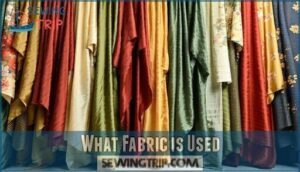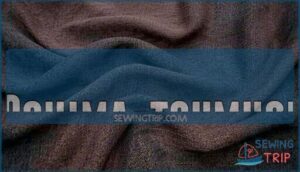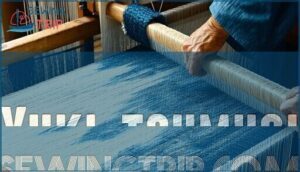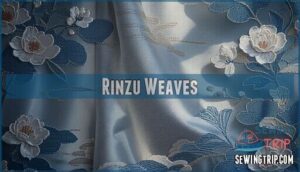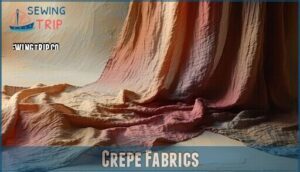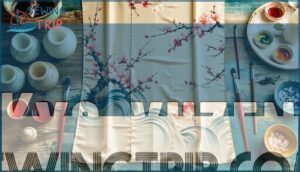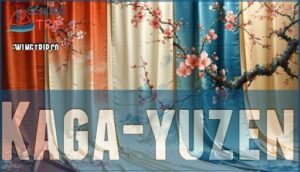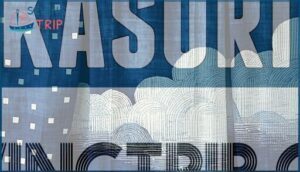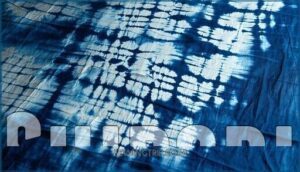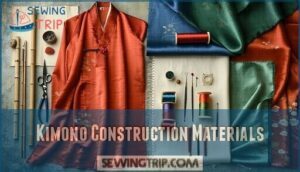This site is supported by our readers. We may earn a commission, at no cost to you, if you purchase through links.
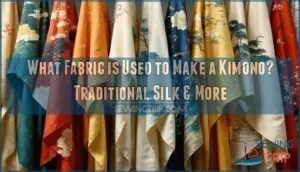 You’ll mainly find silk used for traditional kimonos, though cotton, hemp, and linen work well for casual or summer wear.
You’ll mainly find silk used for traditional kimonos, though cotton, hemp, and linen work well for casual or summer wear.
Silk remains the gold standard because it drapes beautifully and holds intricate dyes perfectly.
Different silk types serve specific purposes – crepe (chirimen) for formal occasions, smooth rinzu for elegant patterns, and textured tsumugi for everyday wear.
Cotton kimonos are perfect for hot weather and beginners, while hemp and linen offer breathable alternatives.
The fabric choice determines everything from formality level to seasonal appropriateness.
Traditional Japanese textile techniques transform these basic materials into true masterpieces through specialized dyeing and weaving methods, making them ideal for everyday wear.
Table Of Contents
Key Takeaways
- You’ll find silk is the top choice for formal kimonos because it drapes well and holds dye beautifully.
- Cotton, hemp, and linen give you breathable, practical options for casual or summer wear.
- The fabric you pick sets the kimono’s formality and comfort, with blends and synthetics offering easy care for daily use.
- Traditional dyeing and weaving techniques turn these fabrics into unique, wearable art that blends history and function.
Kimono Fabric Types
You’ll find kimono made from several distinct fabric types, each serving different occasions and seasons.
Traditional silk remains the most prized choice, while cotton, hemp, and linen offer practical alternatives for everyday wear.
Silk Fabrics
When you’re choosing silk for traditional kimono, you’ll discover luxury beyond compare.
Premium silk grades like Hakata-ori and Chirimen create stunning kimono material through intricate weave variations. Silk durability guarantees your garment lasts generations, while specialized dyeing techniques produce vibrant colors.
Consider these silk kimono essentials:
- High-grade silk costs exceed $1,000 per bolt
- Tsumugi silk offers casual elegance
- Chirimen’s textured weave creates formal beauty
- Silk cost reflects exceptional craftsmanship and longevity
Cotton Fabrics
For casual kimono material, cotton weaves offer exceptional durability and comfort.
Cotton dyeing techniques create vibrant patterns perfect for everyday cotton kimono designs.
This affordable kimono fabric makes traditional Japanese clothing accessible to everyone. Cotton’s breathable nature suits casual wear beautifully.
Modern kimono textiles often feature cotton blends that maintain authenticity while improving practicality for daily use, making traditional Japanese clothing more accessible and everyday wear more comfortable.
Hemp Fabrics
Hemp has been quietly weaving its way into Japanese kimono textiles for centuries.
This remarkably durable natural fiber offers unique advantages for traditional Japanese garment construction.
- Hemp cultivation produces stronger fibers than cotton, making kimono last decades with proper care
- Hemp sustainability appeals to modern makers seeking eco-friendly kimono fabrics online without compromising authenticity
- Hemp texture provides natural breathability and becomes softer with each wear, perfect for summer kimono
- Hemp dyeing accepts natural indigo beautifully, creating stunning blue tones that won’t fade easily
However, some modern kimonos incorporate synthetic fiber advantages for enhanced durability.
Linen Fabrics
Linen offers lightweight breathability that makes it perfect for summer kimono wear.
You’ll find linen characteristics include natural cooling properties and excellent fabric breathability, though it wrinkles easily.
Modern linen kimono often feature linen blends that improve durability while maintaining comfort.
When shopping for kimono fabrics online, linen sourcing typically comes from European flax plants.
Linen durability depends on fiber quality and weaving techniques used in production.
What Fabric is Used
Modern kimono construction relies on several key fabric choices that balance tradition with practicality.
You’ll find that most contemporary kimono use specific fabric types based on their intended purpose and seasonal wear.
The primary fabrics include:
- Silk varieties – Premium choice for formal occasions, offering excellent drape and luxurious appearance
- Cotton blends – Popular for everyday wear, providing comfort and easy maintenance
- Synthetic fibers – Cost-effective option with improved print durability and colorfastness
- Hemp materials – Traditional choice known for breathability and natural texture
- Linen options – Lightweight seasonal fabrics perfect for summer wear.
Fabric weight plays a vital role in kimono construction.
Lighter textiles work best for seasonal fabrics during warmer months, while heavier materials provide structure for formal garments.
Fiber blends have revolutionized modern kimono-making, combining traditional aesthetics with practical benefits.
For cooler weather, consider that wool offers insulation, a property not traditionally associated with kimonos but adaptable for modern designs.
Contemporary dye methods guarantee vibrant colors that resist fading, making these textile traditions accessible to modern wearers who appreciate both beauty and functionality.
Traditional Kimono Fabrics
You’ll find four traditional silk fabrics that define authentic kimono craftsmanship: Oshima-tsumugi, Yuki-tsumugi, Rinzu weaves, and crepe fabrics.
These time-honored textiles showcase Japan’s mastery of silk production and represent centuries of refined weaving techniques, highlighting the country’s expertise in authentic kimono craftsmanship.
Oshima-tsumugi
Oshima-tsumugi represents Japan’s most prestigious silk textile traditions, requiring six to twelve months of painstaking craftsmanship for each kimono.
This pongée weave fabric undergoes unique mud dyeing using iron-rich Amami soil and tannin extracts, creating exceptional durability factors that allow garments to last generations.
Oshima production centers on Kagoshima’s Amami Islands, where skilled artisans preserve ancient techniques. A key element is the traditional mud-dyeing process using teichigi trees.
The export market values these textiles at millions of yen per bolt, reflecting their unmatched quality in traditional Japanese clothing.
Yuki-tsumugi
You’ll find Yuki-tsumugi stands apart from other silk fabrics through its unique material properties and weaving process.
This traditional Japanese clothing uses handspun silk from discarded cocoons, creating remarkably light yet durable fabric. Regional variations between Yuki and Oyama reflect local craftsmanship traditions in textile manufacturing.
Yuki-tsumugi’s designation as a UNESCO cultural heritage highlights its significance.
- Made from silk floss of empty or deformed silkworm cocoons
- Woven on special floor looms called "jibata" for precise tension
- Features matte finish unlike glossy conventional silk production
- Requires months to complete due to intricate kasuri patterning
- UNESCO-recognized craft with limited annual production worldwide
Rinzu Weaves
You’ll find rinzu weaves create stunning tone-on-tone patterns through satin weaving techniques.
These Rinzu Characteristics include lustrous motifs against matte backgrounds, achieved through varying silk thread sheens during kimono weaving.
Rinzu Production uses complex loom work for geometric and floral Rinzu Patterns.
Traditional craftsmanship makes Rinzu Applications perfect for formal kimono, while Rinzu Durability guarantees long-lasting elegance through superior silk production methods.
The satin weave properties create this smooth finish.
Crepe Fabrics
Crepe fabrics bring distinctive texture to traditional kimono through their characteristic puckered surface.
These crinkled weaves create depth and visual interest that catches light beautifully. You’ll find crepe particularly popular for formal occasions where subtle elegance matters most.
- Chirimen crepe – Classic silk crepe with fine wrinkled texture
- Ro crepe – Lightweight summer kimono fabric with open weave
- Sha crepe – Gauze-like crepe perfect for hot weather wear
- Omeshi crepe – Informal silk crepe for everyday kimono
- Hitokoshi crepe – Single-twist silk creating gentle surface texture
Kimono Fabric Techniques
You’ll discover four main dyeing and weaving techniques that transform plain silk into stunning kimono masterpieces.
These traditional methods create the intricate patterns and vibrant colors that make each kimono a wearable work of art.
Kyo-yuzen
Kyo-yuzen transforms plain silk into breathtaking art through hand-painted dyeing techniques.
This Kyoto tradition creates vibrant kimono patterns with nature-inspired design motifs and intricate artistic influence that continues in modern applications of traditional wear.
| Kyo-yuzen History | Dyeing Process | Design Impact |
|---|---|---|
| Originated in late 17th century Kyoto | Rice paste prevents color bleeding | Nature motifs from classical literature |
| Created by fan painter Miyazaki Yuzensai | Multiple artisans work per kimono | Gradient "bokashi" color effects |
| Protected traditional craft since 1976 | Hand-painted brush application | Gold and silver embellishments |
| Symbol of aristocratic luxury | Steaming sets permanent colors | Harmonious tone blending |
| Continues kimono design evolution | Sequential layered dyeing stages | Opulent decorative elements |
Kaga-yuzen
Kaga-yuzen history traces back to Kanazawa’s samurai culture, where artisans developed this luxury kimono dyeing technique using five traditional colors.
You’ll recognize Kaga-yuzen motifs through realistic seasonal designs like cherry blossoms and maple leaves painted on silk.
Modern Kaga-yuzen artists maintain traditional hand-brushing methods while adapting patterns for contemporary cotton and rayon fabrics.
Kaga-yuzen pricing reflects the months-long creation process, with authentic pieces commanding premium prices due to intricate fabric printing techniques and the overall luxury of the product.
Kasuri
Kasuri creates stunning patterns through resist-dyeing threads before weaving.
This ikat weaving technique produces signature blurred designs you’ll recognize on traditional cotton kimono.
Indigo dyeing gives kasuri its deep blue backgrounds with white geometric motifs.
Kasuri history traces back to China’s influence in Japan’s 8th century.
Modern kasuri maintains these time-honored methods while adapting for contemporary cultural attire and kimono making applications, using traditional techniques.
Shibori
When you explore traditional Japanese dyeing methods, Shibori Techniques create stunning resist patterns through binding and folding fabric before Indigo Dyeing.
This ancient art form, particularly Arimatsu Shibori, transforms silk, cotton, and other natural fabrics into unique kimono masterpieces.
Modern Shibori adapts these time-honored methods, producing distinctive Shibori Patterns that celebrate Japanese culture’s artistic heritage.
Kimono Construction Materials
When you’re ready to construct your kimono, you’ll need more than just the main fabric—several specialized materials work together to create the complete garment.
Each component, from the single fabric strip that forms the body to the obi sash that cinches your waist, requires specific materials chosen for both function and traditional aesthetics.
Single Fabric Strip
You’ll find that a kimono uses one continuous fabric strip, typically measuring about 14 inches wide and 12-13 yards long.
One continuous fabric strip creates an entire kimono—14 inches wide, 12-13 yards of pure possibility.
This single piece creates the entire garment through careful fabric manipulation, much like how Japanese culture values simplicity and efficiency.
Here’s how this strip works:
- Main body sections – Front, back, and sleeves cut from the continuous length
- Minimal waste approach – Every inch of cotton or silk fabric gets utilized
- Traditional measurements – Standardized width accommodates various body sizes
This strip quilting method differs from Western tailoring, allowing vintage kimono pieces to be easily reconstructed or repurposed without complex pattern pieces.
Collar Attachment
Several collar attachment methods guarantee your wool kimono maintains proper structure and appearance.
Interfacing usage provides essential collar shaping support, while lining application creates smooth interior surfaces.
Stitching techniques like hand-basting secure fabric layers before permanent attachment.
Reinforcement methods strengthen stress points where collar meets body.
These kimono making fundamentals apply whether you’re kimono sewing with traditional silk or modern wool fabric materials, using techniques like hand-basting to ensure a professional finish.
Obi Sash
Your obi sash acts as the kimono’s centerpiece, crafted from silk brocade or damask with intricate patterns.
Modern obi styles range from formal Fukuro-obi to casual Nagoya-obi, each requiring specific tying techniques.
Obi materials include traditional silk, contemporary wool kimono fabric, and synthetic blends. Many seek out options for purchasing obi silk.
Obi accessories like obijime cords complete the look perfectly.
Obi-age
Beneath the obi’s decorative exterior, you’ll find the obi-age – a silk textile that secures the obi’s padding while adding subtle color coordination.
Traditional Obi-age Materials include fine silk crepe or chirimen, though Modern Obi-age incorporates synthetic blends for affordability.
Formal Obi-age features understated hues that complement your kimono’s palette, while contemporary versions embrace bolder Obi-age Colors.
Many vendors offer beautiful obi-age silk crepe.
Proper Tying Techniques guarantee this cultural heritage element enhances your overall kimono style presentation.
Obi-jime
Wrapped around your obi, this decorative cord serves as the finishing touch that holds everything in place.
Obi-jime materials range from silk to cotton, with intricate braiding techniques creating various textures.
Traditional knot types include the basic bow and elaborate decorative styles.
Color significance reflects seasonal themes and formality levels.
You can find a variety of silk cord options online.
Historical evolution shows how this essential accessory transformed from simple utility to artistic expression, maintaining its role in modern kimono style and cultural heritage.
Han-eri
Han-eri fabrics create the visible collar foundation beneath your kimono’s neckline. These detachable pieces protect the main garment while adding decorative flair.
Han-eri materials and construction details:
- Han-eri materials – White silk crepe or cotton broadcloth for formal wear, synthetic blends for everyday use
- Han-eri colors – Traditional white for ceremonies, subtle pastels or prints for casual occasions
- Han-eri patterns – Plain weaves for simplicity, kimono embroidery for special events
- Han-eri attachment – Basted stitches secure fabric to collar, removable for washing
Han-eri care involves gentle hand washing and proper storage to maintain fabric integrity. Lightweight fabrics like chiffon are ideal, so consider fabric choices for comfort.
Tabi
You’ll wear tabi socks with your kimono outfit, completing the traditional look from head to toe.
Tabi Materials include cotton, silk, or synthetic blends that provide comfort and breathability.
Tabi Construction features a split-toe design with Tabi Fasteners like metal clasps or kohaze hooks along the ankle.
Traditional Tabi Colors are white for formal occasions, though modern versions offer various Tabi Patterns.
These socks connect to the cultural significance of Japanese dress, complementing any kimono embroidery beautifully.
Hair Ornaments
Beyond their stunning kimono fabric choices, traditional Japanese women adorned their hair with intricate ornaments that complemented their garments.
These accessories required specific materials and craftsmanship that matched the kimono’s elegance.
- Kanzashi Styles: Delicate silk flowers, lacquered wood combs, and metal pins created seasonal themes
- Comb Materials: Tortoiseshell, bamboo, and precious metals formed durable bases for ornate designs
- Ornament History: Ancient court traditions influenced modern adaptations seen in contemporary fashion
- Seasonal Hairpins: Spring cherry blossoms, autumn leaves, and winter snowflakes matched fabric patterns
- Modern Adaptations: Today’s designers blend traditional techniques with contemporary materials for accessible beauty
Frequently Asked Questions (FAQs)
What kind of fabric are kimonos made of?
As they say, "the devil’s in the details" – kimonos are traditionally crafted from silk varieties like Hakata-ori, Chirimen, and Tsumugi.
Though you’ll find modern versions using cotton, polyester, and synthetic blends for affordability.
What are expensive kimonos made of?
Expensive kimonos are crafted from premium silk varieties like Hakata-ori, Chirimen, and Tsumugi. High-grade silk can cost over $1,000 per bolt, while vintage silk kimonos fetch auction prices above $10,
How much fabric is needed to make a kimono?
You’ll need approximately 4-5 yards of fabric to make a traditional adult kimono.
This covers the main body, sleeves, and obi sash, though exact amounts depend on your height and desired style.
Why is kimono fabric so narrow?
Like a river flowing through rocky banks, kimono fabric stays narrow because traditional Japanese looms were only 14 inches wide.
You’ll find this narrow tanmono width creates the distinctive straight-line construction that defines authentic kimono design.
How much does kimono fabric cost per yard?
Kimono fabric costs vary dramatically by material.
You’ll pay $4-15 per yard for cotton or synthetic options, while authentic silk runs $50-200+ per yard.
High-grade traditional silks can exceed $300 per yard, which is a dramatic increase in cost.
Where can I buy authentic kimono fabric online?
You’ll find authentic kimono fabrics online at Yoko Beverly Hills, the largest kimono fabric store in the US.
You can also find vintage specialists like Button Bird and Kimono Dream Shop shipping directly from Kyoto, Japan.
What is the difference between vintage and new?
Vintage kimono fabrics showcase centuries-old silk weaving techniques, natural dyes, and hand-crafted artistry, while new fabrics often use synthetic materials, machine production, and modern printing methods for affordability.
How many yards needed for one kimono?
You’ll need approximately 12-14 yards of fabric for a traditional adult kimono. This accounts for the main body, sleeves, collar, and obi sash, depending on your height and desired drape.
Can kimono fabric be machine washed safely?
Like walking on thin ice, you’re treading dangerous territory with machine washing.
Traditional silk kimono fabrics shouldn’t touch washing machines—they’ll shrink, fade, or tear.
Cotton yukata can handle gentle cycles, but synthetic blends offer your safest bet for machine washing.
Conclusion
Like threads weaving through time, the answer to what fabric is used to make a kimono depends on tradition, function, and season.
You’ll find silk at the heart of formal kimonos, prized for its drape and ability to hold dyes.
Cotton, hemp, and linen offer breathable, practical options for daily or summer wear.
Each fabric, shaped by specialized techniques, transforms a kimono into a wearable work of art, blending comfort, beauty, and history with every stitch, showcasing the importance of complete concepts.

